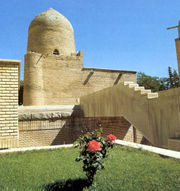Iran: Site of Esther’s Tomb?

Tomb in Hamadan, Iran
Iran made a possible location of the supposed tomb of Esther and Mordecai a national location:
Where is the Tomb of Mordechai and Esther?
Israel National News – March 10, 2009
A few months ago, the normally hostile Iranian regime took the rather unusual step of adding a Jewish holy site to its National Heritage List.
On December 9, 2008, Iranian news outlets reported that the tomb of Mordechai and Esther, heroes of the Purim saga, would now be under official government protection and responsibility.
The move cast a brief spotlight on the site, which is well-known to Iranian Jews but largely unfamiliar to those outside the country. And with Purim being celebrated this week, it is worth taking a moment to ponder this relic of our ancient past.
The mausoleum housing the shrine of Mordechai and Esther consists of a simple brick structure crowned with a dome which was built some five to seven centuries ago over the underground gravesites. It is located in the northwestern Iranian city of Hamadan, which is about 335 kilometers west of the capital, Tehran. According to tradition, Hamadan is believed to be the site of the city of Shushan, which played such a central role in the events described in the Book of Esther.
Various travelers down through the ages took note of the site, with the first having been Benjamin of Tudela, the famed 12th century Jewish explorer…
Interestingly, there is a competing tradition which identifies the traditional burial place of Queen Esther and Mordechai as being on the outskirts of the village of Baram, in the upper Galilee, near Safed.
As early as 1215, Rabbi Menachem Ha-Hevroni wrote that while visiting the Galilee, he came across the tomb of Queen Esther, “who, during her lifetime, had instructed her son Cyrus to bring her there [for burial]”. Later pilgrims mentioned the site, and noted that special celebrations were held there on Shushan Purim.
Currently, the tomb is believed to be located in the ruins of a building found in the Baram National Park.
After the area was liberated in Israel’s War of Independence, a group of Safed Jews went up to the tomb on Purim in 1949 and read the Megillah there to revive the long-standing custom of previous generations.
Hence, we have two conflicting traditions as to where the protagonists of the Purim story are buried, with one placing them in Persia and the other right here in Israel, much closer to home.
And while we can not say with any certainty which of the two traditions is more authentic or correct, of one thing we can all be sure: the deeds of these two great Jewish heroes will never fade from our collective memory. http://www.israelnationalnews.com/News/News.aspx/130362
Furthermore, here is another Jewish report on the location:
Is there any historical evidence of the story of Purim and Queen Esther? Answer: In the high mountains of Iran is a city called Hamadan. Notice that if you remove a “da” from Hamadan, you get “Haman.” I don’t know when Hamadan was renamed, but at one time it was called “Shushan,” and that is where the Queen Esther story takes place. There is a tomb for Queen Esther, and that tomb was built right in the middle of what is now known as Hamadan. http://www.jewishanswers.org/ask-the-rabbi-category/the-jewish-calendar-and-holidays/purim/?p=890
Having not been to either location, it is certainly not clear to me which is correct. However, because the Book of Esther took place outside of Israel, a non-Israeli location seems to make some sense. Haman, by the way was the one who tried to get Mordecai hung, but instead was hanged on the gallows that he had built for Mordecai (Esther 7:9-10).
 |
Tweet |
|